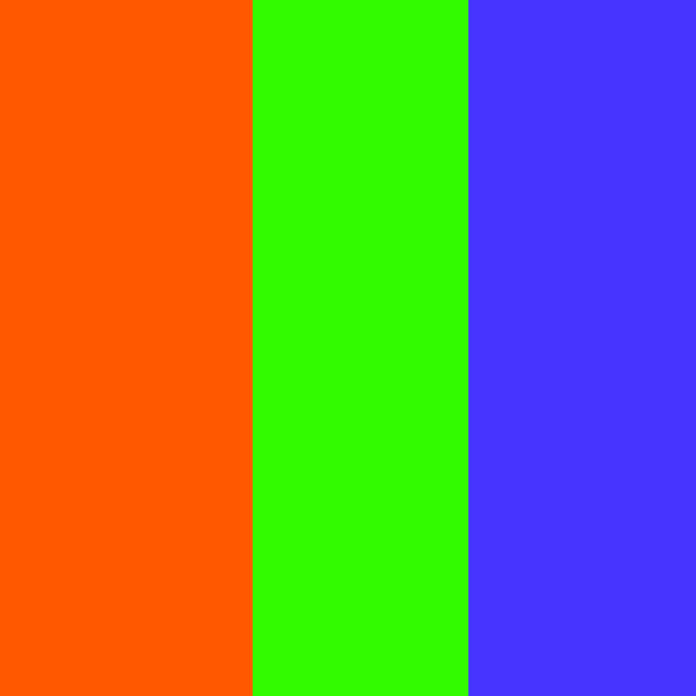Secondary colors
Secondary colors are colors that result from mixing two primary colors in equal proportions. In the traditional color model, the three primary colors are red, blue, and yellow. When these primary colors are mixed, they produce three secondary colors:
Orange: Orange is created by mixing equal parts of red and yellow. It is a warm and vibrant color that combines the energy and passion of red with the brightness and optimism of yellow. Orange is often associated with enthusiasm, creativity, and warmth. In color theory, it is considered complementary to blue.
Green: Green is formed by mixing equal parts of blue and yellow. It is a cool and refreshing color that represents nature, growth, and harmony. Green is often associated with balance, renewal, and tranquility. In color theory, it is considered complementary to red.
Purple: Purple is achieved by mixing equal parts of red and blue. It is a rich and mysterious color that combines the intensity of red with the calmness of blue. Purple is often associated with luxury, spirituality, and creativity. In color theory, it is considered complementary to yellow.
Secondary colors play a significant role in color theory and the color wheel, which is a circular representation of the color spectrum. On the color wheel, secondary colors are located between the primary colors they are derived from. For example, orange is situated between red and yellow, green is between blue and yellow, and purple is between red and blue.
Artists use secondary colors in their work to expand their color palette and create a broader range of hues and tones. Secondary colors can be further mixed with primary colors or other secondary colors to create tertiary colors, which add even more complexity and depth to an artist’s repertoire of colors.
Understanding the properties and characteristics of secondary colors is essential for artists to effectively use color in their artwork. By employing secondary colors alongside primary colors and complementary colors, artists can create harmonious or contrasting compositions that evoke specific emotions and messages in their viewers. The versatility of secondary colors allows artists to experiment and explore various color combinations, adding richness and visual interest to their artistic creations.
Artists can use primary colors in combination to create a wide range of colors and achieve various effects in their artwork. When primary colors (red, blue, and yellow) are mixed, they form secondary and tertiary colors, expanding the artist’s color palette and allowing for a greater diversity of hues. Here are some ways artists can use primary colors in combination:
Mixing Secondary Colors:
By combining two primary colors, artists can create three secondary colors: orange (red + yellow), green (blue + yellow), and purple (red + blue). These secondary colors offer a spectrum of possibilities, providing a more extensive range of colors for artists to work with.
Creating Tertiary Colors:
Tertiary colors are formed by mixing a primary color with a secondary color. For example, mixing red with orange produces a red-orange, while mixing blue with green creates a blue-green. Tertiary colors add further nuance and complexity to an artist’s palette, allowing for more subtle and nuanced variations.
Achieving Color Harmony:
Using primary colors in combination can create color harmony in an artwork. Artists can employ complementary color schemes, where colors opposite each other on the color wheel are used together (e.g., red and green, blue and orange, yellow and purple). Complementary colors create visual contrast and vibrancy in a composition.
Establishing Color Dominance:
Artists can establish color dominance by using one primary color as the dominant hue in a composition and using the other two as supporting colors. This approach can create a focal point and guide the viewer’s eye to a specific area within the artwork.
Modifying Color Temperature:
Mixing primary colors can alter the perceived temperature of a color. For instance, adding more blue to a red hue creates a cooler version of red, while adding more yellow creates a warmer version. Artists can use this technique to convey different moods and atmospheres in their artwork.
Subtle Gradients and Transitions:
Using varying combinations of primary colors allows artists to create smooth gradients and transitions between colors. This technique is particularly useful in representing realistic lighting conditions or subtle shifts in form and tone.
Exploring Color Relationships:
Experimenting with primary colors in combination allows artists to explore the complex relationships between colors. They can discover how colors interact with one another, how they influence each other’s appearance, and how different combinations evoke various emotions and responses in viewers.
Using primary colors in combination is a fundamental aspect of color theory and artistic practice. By mixing and blending primary colors, artists can expand their color palette, achieve harmony and contrast, and convey a wide range of emotions and atmospheres in their artwork. The versatility of primary colors in combination allows artists to explore endless possibilities and infuse their creations with depth, meaning, and visual impact.













